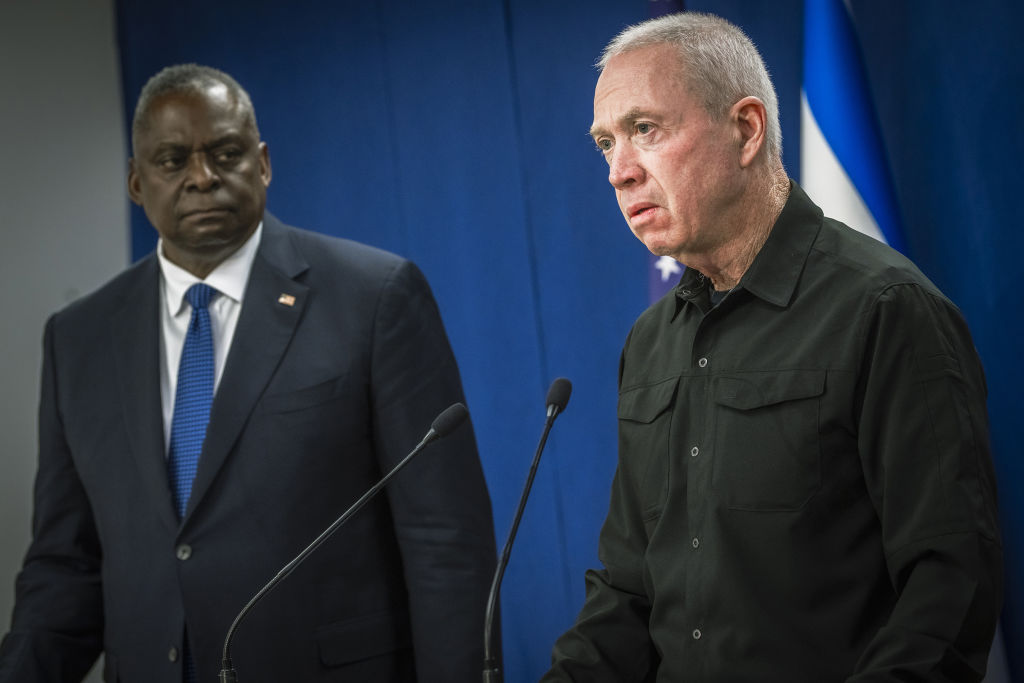As Hamas rockets continue to pour into Israel on a daily basis, American troops are coming under fire from other Iranian-backed armed groups elsewhere in the Middle East. Over the course of a single week, militias targeted U.S. forces in Syria and Iraq in more than a dozen separate attacks.
The timing is no coincidence. As Israel makes the final preparations for a ground offensive in Gaza and the U.S. bolsters its military presence in the region, Iran and its proxies are keeping the threat of a broader regional conflict alive by targeting Americans. It’s a tactic that could lead to deadly escalation.
Where have American troops come under fire?
Israel’s mobilization of troops and military equipment to the perimeter of northern Gaza last week coincided with a number of strikes against U.S. military personnel in Syria and Iraq, as Iranian-backed groups essentially sought to veto America’s support for Israel’s looming offensive with force. The militants’ opening salvo came last Thursday, with three drone barrages targeting U.S. air bases in Syria and Iraq. By Tuesday, according to U.S. defense officials, 13 drone or rocket attacks had targeted American troops in the two Middle Eastern countries.
On Al-Asad Air Base in Iraq, one American contractor died of a cardiac incident while sheltering in place during a false alarm. More than 20 military personnel were injured in the initial wave of attacks, Pentagon spokesman Brig. Gen. Patrick Ryder said Wednesday. The injuries were “minor” and all involved returned to duty, per Ryder, but the assaults show no signs of slowing as Washington prepares for a broader flare-up in the Middle East.
“We’re concerned about potential escalation,” Defense Secretary Lloyd Austin said Sunday.
“In fact, what we’re seeing is the prospect of a significant escalation of attacks on our troops and our people throughout the region.”
Who are the attackers and what are their goals?
According to a senior U.S. defense official, the strikes—which followed President Joe Biden’s visit to Israel and vocal backing of the U.S. ally’s right to defend itself—were facilitated and directed by the Iranian government. “Let’s be clear about it, the road leads back to Iran,” the official said. “Iran funds, arms, equips and trains militias and proxy forces, all across the region that have consistently undermined the stability, cost in civilian life, and at a cost the entire region of security and stability.”
A number of independent analysts agree, pointing to their high level of coordination as evidence of Iran’s fingerprints. A coalition of militias calling itself the “Islamic Resistance in Iraq” has publicly taken credit for at least 11 of the attacks, according to the Washington Institute’s Militia Spotlight, indicating the culprits’ strong links to each other and Iran. “These attacks right now are completely coordinated. In fact, they’re the most coordinated attacks we’ve seen in Iraq and Syria at any point in the post-2003 period,” Michael Knights, co-founder of Militia Spotlight, told The Dispatch. This fact “suggests quite a strong level of Iranian involvement.”
But despite their frequency, the likely aim of the attacks is to signal, not escalate. The strikes are a “clear warning from Iran via its proxies,” said Joe Truzman, a Foundation for Defense of Democracies analyst focused on Palestinian terror groups. “It’s a way to pressure the United States not to get involved in what’s happening between Gaza and Israel.”
What has the U.S. response looked like?
Speaking from Washington, D.C., on Wednesday, Biden cautioned Iran against continuing to target U.S. military personnel. “My warning to the ayatollah was that if they continue to move against those troops, we will respond,” the president said. “And he should be prepared.” But that response has yet to come, and the reluctance may be by design.
Despite the Biden administration’s long history of risk aversion when it comes to responding to Iran’s regional aggression, under normal circumstances such a wave of attacks would have almost assuredly triggered a U.S. response. But with the region sitting on the precipice of cascading conflicts, U.S. officials are seemingly trying to guard against an overreaction with deadly consequences. As unrest mounts across the region in response to Israel’s campaign in Gaza, U.S. retaliation stands to inflame tensions further—which is perhaps the goal for Tehran.
“At the moment, the U.S. isn’t hitting back. Why? It’s not for lack of provocation,” Knights said. “It is because the U.S. might feel like it’s been drawn into striking back to maybe create more anger against it in the region—and particularly in Iraq, where the militias are always trying to put together a kind of political campaign to get U.S. forces thrown out. And if the U.S. hits back in Iraq, that may well be the result.”
Is the conflict in Israel spiraling into a regional war?
Aside from Iran’s reported funding and support for the initial terrorist attack on Israel, Tehran and its proxies have thus far stopped short of full, explicit involvement in the unfolding war. But the prospect of escalation—accidental or intentional—still looms large as Israel prepares for its invasion of Gaza.
Hezbollah, an Iranian-backed Lebanese group to Israel’s north, has already threatened to attack Israel in the event of a ground war in Gaza. The militants currently boast an arsenal of more than 150,000 mortars, rockets, and missiles capable of unleashing significant destruction on Israel’s residential areas and critical infrastructure. So far, the group’s involvement has been limited to cross-border missile attacks on Israeli military outposts near the border. But that could change as Israel launches its operation to defeat Hamas, and if Hezbollah joins the war other Iranian-backed groups may soon follow.
“Everybody’s just waiting to see if Hezbollah is going to join, and then basically the dominoes will fall from there,” Truzman said. “But it’s clear, because of the bolstering of the U.S. military hardware that’s in the region, that they’re expecting something big.”
That threat could come from Iran’s proxies in Syria and Iraq, but it could also emerge from its network of well-armed militias elsewhere in the region. A U.S. destroyer in the northern Red Sea on Friday shot down missiles fired from Yemen by the Iranian-backed Houthis in the direction of Israel. Saudi Arabia, the Houthis’ longtime enemy, reportedly also intercepted a missile believed to be destined for Israel.
What is the U.S. doing to prevent a broader conflict?
Administration officials are hoping that bolstering the U.S. military presence in the region will deter the broader conflict Iran is currently threatening. Short of that, they hope the deployments will help manage the crisis if and when it comes. In addition to sending two Navy aircraft carriers and a rapid response force of 2,000 Marines, the U.S. will reportedly deploy nearly a dozen additional Patriot air defense systems to the Middle East, including the Gulf.
In the meantime, the Biden administration is urging Israel to exercise extreme caution as it carries out airstrikes on terrorist targets and prepares to go into Gaza. Last week’s conflicting reporting on a blast at a Gaza hospital demonstrated the danger. After hundreds of civilian deaths were wrongfully attributed to Israel, massive riots targeting U.S. and Israeli embassies and consulates engulfed the Middle East. Such a high-casualty event in the future could result in a region-wide escalation. “Hamas uses its media, the images that come out of Gaza as a rallying cry for the Arab world, especially their allies,” said Truzman. “One bad incident can throw the region into this death spiral.”
Iranian-backed groups could seize on the campaign in Gaza to open fronts against Israel and the U.S. from the West Bank, Lebanon, Syria, Iraq, Iran, or elsewhere. The U.S. hopes its strong presence in the region can prevent the large-scale, coordinated attack long feared by the Israeli security establishment.
“We’re there to sort of prevent that big stuff from happening. Exactly how we’re doing that is undefined, and that’s the point—you don’t really want to define it too much,” Knights said. “You just park those carriers there and all those Air Wings, and you make a lot of threatening noises, and you create uncertainty. What we’re trying to do is to basically isolate the battlefield from the broader axis of resistance, and leave the Israelis with just Hamas to fight.”
“They thought they could deter Israel from going after Hamas, but they didn’t count on the U.S. coming in so heavily as a counter-deterrent.”
Click here for more coverage of the war in Israel.
Correction, October 26, 2023: The caption beneath the Getty photograph we featured in this story originally identified the U.S. Defense secretary as Austin Lloyd, rather than Lloyd Austin.







Please note that we at The Dispatch hold ourselves, our work, and our commenters to a higher standard than other places on the internet. We welcome comments that foster genuine debate or discussion—including comments critical of us or our work—but responses that include ad hominem attacks on fellow Dispatch members or are intended to stoke fear and anger may be moderated.
With your membership, you only have the ability to comment on The Morning Dispatch articles. Consider upgrading to join the conversation everywhere.